 Loading... Please wait...
Loading... Please wait...Wood Veneer Tutorials
Wood Veneer How-To Videos
Finishing Wood Veneers Made Easy
Finishing Wood Veneers - A Short Course
By Bob Morgan, Pres., Veneer Factory Outlet.com
Hello, I’m Bob Morgan with the Veneer Factory Outlet.com and Bob Morgan Woodworking Supplies. Today we’re going to talk about how to apply a stain or a finish to a veneered surface.
Apply A Stain Or Finish To Veneer The Same You Would To Any Wooden Surface
First, remember this: You apply a stain or a finish to a veneered surface the same way that you apply a stain or a finish to any wooden surface. There’s no difference. Veneer is wood and you treat it the same way that you would treat any wooden surface. The staining and finishing is usually done after you glue the veneer in place. However, you can stain and finish the veneer ahead of time if you choose to.
Sanding Wood Veneers
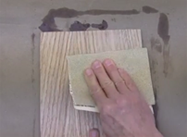 Most of our veneers are pre sanded at our factory, so for most of our veneers, it is not necessary to sand before you apply the first coat of finish. If sanding is necessary, it’s surprising how much you can sand without sanding through the veneer. Just proceed with some caution.
Most of our veneers are pre sanded at our factory, so for most of our veneers, it is not necessary to sand before you apply the first coat of finish. If sanding is necessary, it’s surprising how much you can sand without sanding through the veneer. Just proceed with some caution.
The most common mistake people make when sanding wood veneer is to be overly cautious. This causes them to use too fine of a sandpaper.
The coarseness of sandpaper is described by a number. The higher the number, the finer the sandpaper. The lower the number, the coarser. A good sandpaper number to start with is 100.
Start with 100 grit. If you need a heavier grit, switch to an 80 grit. If you need a finer grit, switch to a 120 grit.
Naturally, the coarser the grit (lower numbers), the faster you will be able to sand.
It is generally best to increase the grit number to higher and higher values during the sanding process. Do this in 2 or 3 steps, using higher and higher grits as you proceed. You can finish sand your work with a 140 grit or above.
Staining Wood Veneer
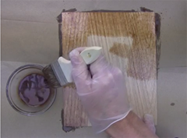 You can apply a stain to your wood veneer if you want to, but you don’t have to. If you want to change the color or hue of the wood, staining will be necessary.
You can apply a stain to your wood veneer if you want to, but you don’t have to. If you want to change the color or hue of the wood, staining will be necessary.
Some stains are available as a finish and a stain all in one. I do not recommend these.
The staining process is straightforward. Apply the stain with a rag or a brush and then let it sit for a minute or two. The longer you let the stain sit, the deeper the stain will penetrate and the darker it will stain the veneer.
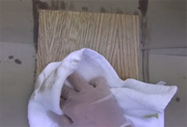 After a couple of minutes, use a clean rag to wipe off the excess stain. If you want to stain your wood darker, you can apply a second coat of stain, wipe it off and look to see if you get the desired results. Allow the stain to cure for about 24 hours before you apply a finish.
After a couple of minutes, use a clean rag to wipe off the excess stain. If you want to stain your wood darker, you can apply a second coat of stain, wipe it off and look to see if you get the desired results. Allow the stain to cure for about 24 hours before you apply a finish.
That’s it. It’s that simple. You can stain and re stain as many times as you want. Just remember that for most stains it is necessary to apply the stain, let it sit for a minute or two, and wipe it off.
Hint: Generally, pick a stain that looks a little lighter than the shade that you want to end up with. Stains just generally tend to darken the wood a little more than one might think.
Finishing Wood Veneer
There are so many different types of finishes that it is beyond the scope of this tutorial to talk about all of them. For this tutorial I will discuss varnish and shellac.
The instructions that I give you here will apply to most of the other kinds of finishes. Always be sure to read and follow the instructions for whatever finish you choose.
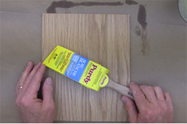 You can brush your first coat and the intermediate coats. Be sure to use a good brush for this. I like to use a new brush, especially on important projects. For solvent based finishes, use a brush that has natural bristles. For water based finishes, use a brush that has synthetic bristles.
You can brush your first coat and the intermediate coats. Be sure to use a good brush for this. I like to use a new brush, especially on important projects. For solvent based finishes, use a brush that has natural bristles. For water based finishes, use a brush that has synthetic bristles.
Polyurethane varnish is a good all around choice for most projects. There are two types of polyurethane varnishes – water based and solvent based. I like both of them.
The water based varnishes dry quickly, they release almost no fumes, and you use water for cleanup. Water based polyurethane finishes may cure in as little as 6 hours.
The solvent based polyurethane finishes give off fumes and you should work in a well ventilated area where there is no fire hazard. Solvent based polyurethane finishes take about 24 hours to cure.
The solvent based polyurethane varnishes exhibit an amber patina when they dry. This amber patina is not as prominent in the water based varnishes. The manufacturers have added the amber patina to the water based varnishes, but with limited success. Most people prefer the look of the solvent based varnishes.
Shellac is an alchohol based finish that dries rapidly and gives good results with few problems. However, it isn't anywhere near as durable and protective as varnish.
Some people prefer to apply a wood filler to the wood surface before they apply a finish. The advantage to using a filler is that it helps to fill up the pores in the surface, making the surface of the wood smoother and a little easier to finish.
I don’t like fillers because they tend to dull down the luster of the wood. Wood fillers are easy to use. If you choose to use a wood filler, just follow the directions on the can.
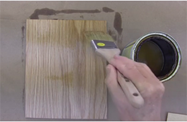 Generally, it will be necessary to apply a minimum of 3 coats of finish. Apply thin coats of finish, not heavy coats. Use light strokes, and brush in the same direction as the grain. Allow each coat to dry thoroughly. Sand between coats. Apply the first coat and let it cure. Then sand with about a 120 or 140 grit or higher if you think it is appropriate.
Generally, it will be necessary to apply a minimum of 3 coats of finish. Apply thin coats of finish, not heavy coats. Use light strokes, and brush in the same direction as the grain. Allow each coat to dry thoroughly. Sand between coats. Apply the first coat and let it cure. Then sand with about a 120 or 140 grit or higher if you think it is appropriate.
Apply the second coat and allow it to dry. Then sand again. Generally speaking, you will use finer and finer sandpaper (higher number grits) for each successive coat of finish.
You do the final sanding before you apply the last coat.
For the final sanding, use a fine grit such as a 220 grit or above (even up to 600 grit). After the final sanding, apply the final coat of finish. I recommend that you spray the final coat.
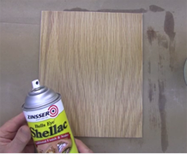 Varnishes and shellacs can be brushed or sprayed. In my opinion, you should brush the first few coats and spray the last coat. When you spray the last coat, you avoid brush marks and the finish goes on smoothly and uniformly. When spraying the finish, be careful not to spray too heavy of a coat.
Varnishes and shellacs can be brushed or sprayed. In my opinion, you should brush the first few coats and spray the last coat. When you spray the last coat, you avoid brush marks and the finish goes on smoothly and uniformly. When spraying the finish, be careful not to spray too heavy of a coat.
Some people prefer further steps, such as using steel wool, pumice or rottenstone to add further smoothness and luster to the surface.
Hint: If you don’t like your final results, you can sand the surface again and apply further coats of finish until you are satisfied.
For more information, watch the 15 minute video, below. I’m Bob Morgan with Bob Morgan Woodworking Suppies and the Veneer Factory Outlet.com
Staining And Finishing Wood Veneers















